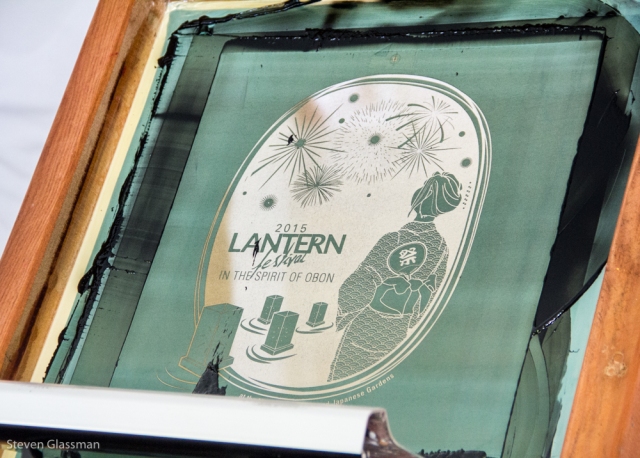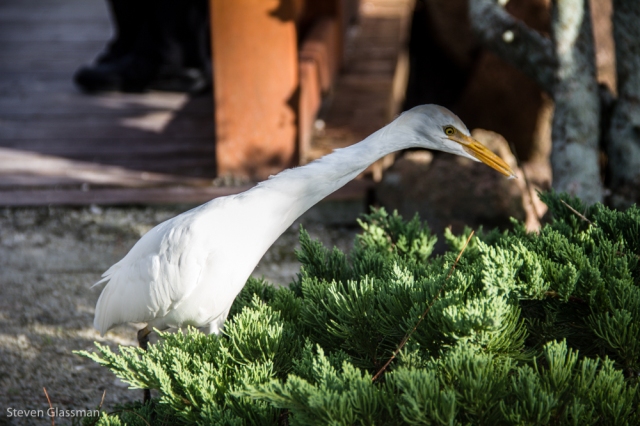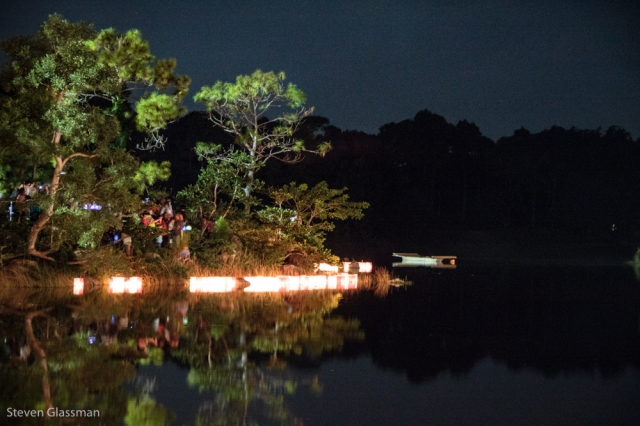Allow me to step away from my neverending flurry of Japan posts to talk about… Japanese culture in South Florida! This weekend was the 2015 Morikami Lantern Festival: In The Spirit Of Obon.
First, a little bit of history: In 1903, a Japanese man named Jo Sakai who had recently graduated from New York University purchased 1000 acres of land from Henry Flagler’s Model Land Company, in order to build a farming community. Jo Sakai recruited young men from his home town of Miyazu, Japan to help farm the land. The Yamato Colony was located in what is now Boca Raton, Florida. One of their main crops was pineapples, and the pineapple is a symbol of nearby Delray Beach to this day. A major East-West roadway in Boca Raton is still called Yamato Road, and I drive that road every time I go to work.
Over time, the Yamato Colony could no longer compete with cheaper pineapples from nearby Cuba. Most of the farmers returned to Japan, and those who remained lost much of their land when the United States government took it during World War II to build an Army Air Corps training base. That land is currently part of Florida Atlantic University and the local Boca Raton Airport. Shoppers leaving the Whole Foods off Glades Road in Boca Raton can still see giant Army turrets left over from the military base bordering the field of the local high school.
The lone member of the Yamato Colony to remain in the area was George Morikami. George migrated to the area from Miyazu in 1906, and he stayed in the area after the Yamato Colony disbanded. He purchased land in Delray Beach after World War II, and farmed it for almost thirty years. George Morikami died at age 89 in 1976, and his ashes were returned to Miyazu. Nearby Delray Beach is a sister city to Miyazu, in his honor.
Before George died, he donated his land to Palm Beach County, and that land became the Morikami Park and Japanese Gardens. Ground breaking for Morikami Park was in 1976, and the museum building on site began construction in 1993.
The Museum and Gardens have been celebrating the Bon festival for many years. Obon has traditionally been celebrated in July or August, but the Morikami changed their celebration a few years ago to be slightly later in the year in order to better avoid summer weather conditions. The newer festival was combined with another fall Lantern celebration, and thus is called “The Morikami Lantern Festival: In The Spirit of Obon.”
Now that we’ve got that background out of the way, let’s talk about the festival! As with any festival in Florida, there are tents for small wares- tea, jewelry, and the like.
There were entertainment tents for the children, including facepainting, ring toss games, and a Doraemon’s Pocket game where children can toss a small bean bag into Doraemon’s pocket to win prizes. Not familiar with Doraemon? He’s a robot cat from the future, and he’s very popular in Japan.
A local screen printing company was working on the official shirts for the festival. If you’ve never watched screen printing being done, it’s worth a look. The entire process is just fascinating.
The design for the event logo is beautiful. The Fine Print Shoppe does nice work.
There were food options at the festival as well. Some of the food choices were typical American festival fare, but most of the food booths were either Japanese or Japanese-inspired foods. Amelie and I ate Takoyaki, a round and battered snack which is traditionally filled with octopus, tempura, ginger, and onion, but was made at the Morikami with chicken instead of octopus. We also tried Kinoko Gohan, a type of brown rice with mushroom in it. Both dishes were delicious.
Emboldened by the delicious flavors of the other two, we tried a dessert called Dango. Dango is a semi-sweet dumpling made of mochiko (rice flour), and covered in a syrup made of soy sauce, sugar, and starch. Neither of us enjoyed this as much as the other dishes we had tried- the texture was very dense, and the syrup brought very little sweetness to the whole concoction. As a dessert, this kind of failed for me.
In order to cleanse your mental palate from the foodstuffs, let me show you around the park a little bit. They have a Bonsai work area where they grow and trim many varieties of the sprightly little trees.
The garden has long winding pathways on which you might stroll with pretty girlfriends. Here’s mine.
There are waterfalls and stone paths over water, as well as wooden boardwalks over some pools.
There is a proper zen garden. While we were in this area, we overheard a young frat boy asking the attendant if the design was ever changed. When he was told that it was not, he suggested (with a blinding surge of stupidity) that they should cover it in a coat of clear acrylic.
There are nooks and crannies on the pathways around the garden. On one particular nook, there’s a bamboo water pipe which fills and then dips each time it is too full:
The entire garden wraps around a very large lake.
One part of the garden is a small bamboo forest. The sound of bamboo rubbing against other bamboo is unlike any other sound on Earth. Not that I haven’t tried to imitate it. Quite a lot, in fact.
Near the main museum is a stone ring on a stand. I don’t truly understand the significance of the stone, but it’s pretty and photogenic. And a banana spider has made a web in the center of the ring which catches the light very nicely.
This little fellow didn’t seem overly concerned with the hordes of humans present in the park on Saturday. He was hunting for food and wandered right past me, no more than an arm’s length away.
There are several bridges in the park demonstrating various types of Japanese architecture. I couldn’t begin to tell you much about this one, but it’s nice looking, don’t you think?
Now that you have a better idea of the setting, let me show you some of the entertainment. There were rotating shows, three times each, of two Japanese arts. The first was Japanese folk dancing by Chitose Kai.
Some of the folk dancing was assisted by members of the second group, the Fushu Daiko Taiko drumming troupe.
Founded in 1990, Fushu Daiko is celebrating its 25th anniversary this year. That big drum behind the group? They call it Godzilla.
It’s difficult to get clear shots of the drummers- they’re very fast.
Fushu Daiko teaches classes in their dojo, so the students also perform at some shows.
I’m not gonna lie to you- Taiko drumming is super cool to watch. I’m not going to talk about the next nine photos. Just look through them slowly, and then figure out when you can go see a Taiko show. For those of you in Orlando, just go to Epcot- they do it there every day. I’ll see you after the Fushu Daiko pictures.
Welcome back! How did you like the Taiko drums?
By the time the final drumming finished up, there were only a few things left to do at the festival. There was a little more shopping available- these lights were much prettier after dark than they were in the daytime.
The lantern part of the lantern festival was close to the end of the evening. Visitors were encouraged to purchase and build a floating lantern or a tanzaku slip in memory of a loved one. These lanterns would then float across Morikami Lake at the end of the evening. There wasn’t much of a breeze, so the lanterns didn’t move very much. They still looked pretty nifty, though.
Finally, just before the close of the festival, there were fireworks. Lots of them, right over the corner of Morikami Lake.
Have you ever been to the Morikami Museum and Gardens? Have you ever been to a Bon Festival?


































Absolutely amazing photos!!
I love taiko so much. I wish there was a group near me. It’s amazing for fitness, too.
LikeLike
Thanks! It was nice to have a reason to bring out the good camera again! I hadn’t used it since Japan a few months ago.
LikeLike
>Have you ever been to a Bon Festival?
Yes. Many times. But never in Florida…even though I grew up there!
Thanks for visiting my blog ( http://tokyo5.wordpress.com )
LikeLike
Fushu Daiko was founded the year you moved to Japan, and most of the structure of the current Morikami museum was built after that point. Do you ever go back to Florida for a visit?
LikeLike
Not often. Too expensive. I went there last August though…but only for a few days and only because of a family emergency. Before that was eleven years ago…and that was my first visit there since I moved here.
LikeLike
Not often. I did go there this past August though for a few days…but that was for a family emergency.
Before that was eleven years ago…and that was my first visit since I moved here.
LikeLike
Yes! I went to the Morikami twice – once when I was too little to remember anything, and once when it was too dark out to see anything (I was playing in chamber group that provided music for some fancy society party thing).
Also the history was fascinating! I had no idea about the background of Morikami.
LikeLike
I really enjoy it when I learn neat stuff in the course of researching background for a blog post. This was one of those occasions.
LikeLiked by 1 person